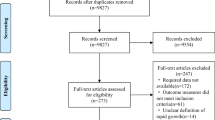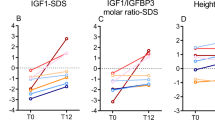Abstract
Background/objectives
Glucose Transporter 1 Deficiency Syndrome (GLUT1-DS; OMIM #606777) is a rare disease caused by dominant mutations in SLC2A1 encoding GLUT1, which is a ubiquitous transporter of glucose across plasma membranes, particularly across the blood-brain barrier. Hypoglycorrhachia symptoms are the cornerstones of GLUT1-DS, but delayed growth has also been suggested. This led us to investigate, at diagnosis, the relationship between the glycemia/glycorrhachia ratio and the nutritional and growth pattern phenotype of 30 GLUT-DS patients.
Subjects/methods
An assessment was made of body weight (BW), body length/height (BL, BH) and body composition by anthropometry and DEXA, and the results put with BL and BW at birth, genetic target, glycemia, insulinemia, and glycorrhachia values.
Results
At birth, 21% of patients had a BW below −1.645 z-score, whereas no patients had BL below the reference values. At diagnosis 23% of the patients had an impaired nutritional status, 19.2% and 3.8% being respectively underweight and overweight/obese; 10%, all under 10 years old, had BL/BH below −1.645 z-score, with no specific features related to body composition. Finally, there was no association between glycemia, glycorrhachia, and growth phenotype.
Conclusions
GLUT1-DS is associated with impaired BW but not BL intrauterine growth, with a slower than normal pattern of growth rather than growth failure. These data could be useful for the interpretation of any long-term effects of the ketogenic diet, e.g. nutritional and growth pattern decline.
This is a preview of subscription content, access via your institution
Access options
Subscribe to this journal
Receive 12 print issues and online access
$259.00 per year
only $21.58 per issue
Buy this article
- Purchase on Springer Link
- Instant access to full article PDF
Prices may be subject to local taxes which are calculated during checkout
Similar content being viewed by others

References
De Giorgis V, Veggiotti P. GLUT1 deficiency syndrome 2013: current state of the art. Seizure. 2013;22:803–11.
Uldry M, Thorens B. The SLC2 family of facilitated hexose and polyol transporters. Pflug Arch. 2004;447:480–9.
Maher F, Vannucci SJ, Simpson IA. Glucose transporter proteins in brain. Faseb J. 1994;8:1003–11.
Klepper J, Leiendecker B. GLUT1 deficiency syndrome-2007 update. Dev Med Child Neurol. 2007;49:707–16.
Klepper J. GLUT1 deficiency syndrome in clinical practice. Epilepsy Res. 2012;100:272–7.
Klepper J. Glucose transporter deficiency syndrome (GLUT1DS) and the ketogenic diet. Epilepsia. 2008;49 Suppl 8:46–9.
Klepper J, Diefenbach S, Kohlschutter A, Voit T. Effects of the ketogenic diet in the glucose transporter 1 deficiency syndrome. Prostaglandins Leukot Ess Fat Acids. 2004;70:321–7.
De Giorgis V, Masnada S, Varesio C, Chiappedi MA, Zanaboni M, Pasca L, et al. Overall cognitive profiles in patients with GLUT1 deficiency syndrome. Brain Behav. 2019;0:e01224.
Phase 2 Study of Triheptanoin (UX007) for the Treatment of Glucose Transporter Type 1 Deficiency Syndrome (Glut1 DS). Identifier: NCT01993186. https://clinicaltrials.gov/ct2/show/study/NCT01993186. Accessed 21 Jan 2019.
Nakagama Y, Isojima T, Mizuno Y, Takahashi N, Kitanaka S, Igarashi T. Growth hormone deficiency: a possible complication of glucose transporter 1 deficiency? Acta Paediatr. 2012;101:e259–62.
Bertoli S, Neri IG, Trentani C, Ferraris C, De Amicis R, Battezzati A, et al. Short-term effects of ketogenic diet on anthropometric parameters, body fat distribution, and inflammatory cytokine production in GLUT1 deficiency syndrome. Nutrition. 2015;31:981–7.
Tanner JM, Goldstein H, Whitehouse RH. Standards for children’s height at ages 2-9 years allowing for heights of parents. Arch Dis Child. 1970;45:755–62.
Wechsler D. Wechsler preschool and primary scale of intelligence. 4th ed. San Antonio, TX: Psychological Corporation; 2012.
Orsini A, Pezzuti L, Picone L. Wechsler intelligence scale for children. 4th ed Italian Edition. Firenze, IT: Giunti O.S.; 2012.
Griffiths R. The abilities of young children. A comprehensive system of mental measure for the first eight years of life: courns Wood House. North Dean, High Wycombe: The Test Agency;; 1984.
Lohman TG, Roche AF, Martorell R. Anthropometric standardization reference manual. Champaign, IL: Human Kinetics Books; 1988.
Centers for Disease Control and Prevention, National Center for Health Statistics. CDC Growth Charts. 2000. https://www.cdc.gov/growthcharts/cdc_charts.htm.
Addo OY, Himes JH. Reference curves for triceps and subscapular skinfold thicknesses in US children and adolescents. Am J Clin Nutr. 2010;91:635–42.
Metter EJ, Talbot LA, Schrager M, Conwit R. Skeletal muscle strength as a predictor of all-cause mortality in healthy men. J Gerontol A Biol Sci Med Sci. 2002;57:B359–65.
Frisancho AR. Anthropometric standards for the assessment of growth and nutritional status. Ann Arbor, MI: University of Michigan Press; 1990.
Butte NF, Hopkinson JM, Wong WW, Smith EO, Ellis KJ. Body composition during the first 2 years of life: an updated reference. Pediatr Res. 2000;47:578–85.
McCarthy HD, Cole TJ, Fry T, Jebb SA, Prentice AM. Body fat reference curves for children. Int J Obes (Lond). 2006;30:598–602.
Kelly TL, Wilson KE, Heymsfield SB. Dual energy X-Ray absorptiometry body composition reference values from NHANES. PLoS One. 2009;4:e7038.
Spadafranca A, Cappelletti C, Leone A, Vignati L, Battezzati A, Bedogni G, et al. Relationship between thyroid hormones, resting energy expenditure and cardiometabolic risk factors in euthyroid subjects. Clin Nutr. 2015;34:674–8.
Gandhi K. Approach to hypoglycemia in infants and children. Transl Pediatr. 2017;6:408–20. https://doi.org/10.21037/tp.2017.10.05
World Health Organization. Definition, diagnosis and classification of diabetes mellitus and its complications. Report of a WHO consultation. Part 1: Diagnosis and classification of diabetes mellitus. 59pWHO/NCD/NCS/99.2. Geneva: World Health Organization; 1999.
Sperling MA. Pediatric endocrinology. 4 ed. Philadelphia, PA: Saunders Elsevier; 2014.
Matthews DR, Hosker JP, Rudenski AS, Naylor BA, Treacher DF, Turner RC. Homeostasis model assessment: insulin resistance and beta-cell function from fasting plasma glucose and insulin concentrations in man. Diabetologia. 1985;28:412–9.
Shashaj B, Luciano R, Contoli B, Morino GS, Spreghini MR, Rustico C, et al. Reference ranges of HOMA-IR in normal-weight and obese young Caucasians. Acta Diabetol. 2016;53:251–60.
Muniyappa R, Lee S, Chen H, Quon MJ. Current approaches for assessing insulin sensitivity and resistance in vivo: advantages, limitations, and appropriate usage. Am J Physiol Endocrinol Metab. 2008;294:E15–26.
Larsen J, Johannesen KM, Ek J, Tang S, Marini C, Blichfeldt S, et al. The role of SLC2A1 mutations in myoclonic astatic epilepsy and absence epilepsy, and the estimated frequency of GLUT1 deficiency syndrome. Epilepsia. 2015;56:e203–8.
Coman DJ, Sinclair KG, Burke CJ, Appleton DB, Pelekanos JT, O’Neil CM, et al. Seizures, ataxia, developmental delay and the general paediatrician: glucose transporter 1 deficiency syndrome. J Paediatr Child Health. 2006;42:263–7.
Ellis KJ, Shypailo RJ, Pratt JA, Pond WG. Accuracy of dual-energy x-ray absorptiometry for body-composition measurements in children. Am J Clin Nutr. 1994;60:660–5.
Goran MI, Driscoll P, Johnson R, Nagy TR, Hunter G. Cross-calibration of body-composition techniques against dual-energy X-ray absorptiometry in young children. Am J Clin Nutr. 1996;63:299–305.
Leen WG, Klepper J, Verbeek MM, Leferink M, Hofste T, van Engelen BG, et al. Glucose transporter-1 deficiency syndrome: the expanding clinical and genetic spectrum of a treatable disorder. Brain. 2010;133:655–70. Mar
Acknowledgements
We would like to thank the patients with GLUT1 deficiency syndrome, their families, and the “Italian Association GLUT1 ONLUS” for their participation in the study. We also thank Greta Gambacorta for her help in the data collection, and Adrian Wallwork and Barbara Carey for the English revision.
Funding
This study was supported by the International Center for the Assessment of Nutritional Status (ICANS) and by the Department of Pediatrics, V. Buzzi Children’s Hospital, University of Milan.
Author information
Authors and Affiliations
Contributions
Conceptualization, SB and CM. Methodology, SB and CM. Formal analysis, AL. Investigation, RD, CL, CF, AS and MG. Data management, SB, CM, SM and PV. Writing—original draft preparation, SB, CM, AL, RD and SM. Writing—review and editing, AT, PV, AB, VD, and GZ. Funding acquisition, SB, CM, PV, and GZ. All authors approved the final version.
Corresponding author
Ethics declarations
Conflict of interest
The authors declare that they have no conflict of interest.
Additional information
Publisher’s note Springer Nature remains neutral with regard to jurisdictional claims in published maps and institutional affiliations.
Supplementary information
Rights and permissions
About this article
Cite this article
Bertoli, S., Masnada, S., De Amicis, R. et al. Glucose transporter 1 deficiency syndrome: nutritional and growth pattern phenotypes at diagnosis. Eur J Clin Nutr 74, 1290–1298 (2020). https://doi.org/10.1038/s41430-020-0662-z
Received:
Revised:
Accepted:
Published:
Issue Date:
DOI: https://doi.org/10.1038/s41430-020-0662-z


